Laser Output Performance and Temporal Quality Enhancement at the J-KAREN-P Petawatt Laser Facility
Abstract
:1. Introduction
2. Overall J-KAREN-P Laser System Architecture and Output Performance
3. Spatial Beam Characterization
4. Temporal Beam Characterization
4.1. Femtosecond Pre-Pulse Generated by Post-Pulse in the Second CPA Stage
4.2. Picosecond Pedestal Due to the Random Spectral Phase Noise of the Main Pulse (RSPN)
4.3. Femtosecond Pre-Pulse Generated by Post-Pulse in the First CPA Stage
4.4. Residual Pre-Pulses
5. Automation Initiative of the J-KAREN-P Laser System
6. Conclusions
Author Contributions
Funding
Institutional Review Board Statement
Informed Consent Statement
Data Availability Statement
Acknowledgments
Conflicts of Interest
References
- Strickland, D.; Mourou, G. Compression of amplified chirped optical pulses. Opt. Commun. 1985, 56, 219–221. [Google Scholar] [CrossRef]
- Moulton, P.F. Spectroscopic and laser characteristics of Ti:Al2O3. J. Opt. Soc. Am. B 1986, 3, 125–133. [Google Scholar] [CrossRef]
- Spence, E.D.; Kean, E.D.; Sibbet, W. 60-fsec pulse generation from a self-mode-locked Ti:sapphire laser. Opt. Lett. 1991, 16, 42–44. [Google Scholar] [CrossRef]
- Danson, C.N.; Haefner, C.; Bromage, J.; Butcher, T.; Chanteloup, J.-C.F.; Chowdhury, E.A.; Galvanauskas, A.; Gizzi, L.A.; Hein, J.; Hillier, D.I.; et al. Petawatt and exawatt class lasers worldwide. High Power Laser Sci. Eng. 2019, 7, e54. [Google Scholar] [CrossRef]
- Nakamura, K.; Mao, H.; Gonsalves, J.A.; Vincenti, H.; Mittelberger, E.D.; Daniels, J.; Magana, A.; Toth, C.; Leemans, W.P. Diagnostics, control and performance parameters for the BELLA high repetition rate petawatt class laser. IEEE J. Quantum Electron. 2017, 53, 1200121. [Google Scholar] [CrossRef]
- Wang, Y.; Wang, S.; Rockwood, A.; Luther, B.M.; Hollinger, R.; Curtis, A.; Calvi, C.; Menoni, C.S.; Rocca, J.J. 0.85PW laser operation at 3.3 Hz and high-contrast ultrahigh-intensity λ= 400nm second-harmonic beamline. Opt. Lett. 2017, 42, 3828–3831. [Google Scholar] [CrossRef]
- Sung, J.H.; Lee, H.W.; Yoo, J.Y.; Yoon, J.W.; Lee, C.W.; Yang, J.M.; Son, Y.J.; Jang, Y.H.; Lee, S.K.; Nam, C.H. 4.2PW, 20 fs Ti: Sapphire laser at 0.1 Hz. Opt. Lett. 2017, 42, 2058–2061. [Google Scholar] [CrossRef] [PubMed]
- Ziegler, T.; Albach, D.; Bernert, C.; Bock, S.; Brack, E.-F.; Cowan, E.T.; Garten, M.; Gaus, L.; Gebhardt, R.; Helbig, U.; et al. Proton beam quality enhancement by spectral phase control of a PW-class laser system. Sci. Rep. 2021, 11, 7338. [Google Scholar] [CrossRef]
- Schramm, U.; Bussmann, M.; Irman, A.; Siebold, M.; Zeil, K.; Albach, D.; Bernert, C.; Bock, S.; Brack, F.; Branco, J.; et al. First results with the novel Petawatt laser acceleration facility in Dresden. J. Phys.: Conf. Ser. 2017, 874, 012028. [Google Scholar] [CrossRef]
- Center for Advanced Laser Applications. Available online: http://www.cala-laser.de (accessed on 22 June 2023).
- Li, W.; Gan, Z.; Yu, L.; Wang, C.; Liu, Y.; Guo, Z.; Xu, L.; Xu, M.; Hang, Y.; Xu, Y.; et al. 339 J high-energy Ti: Sapphire chirped-pulse amplifier for 10 PW laser facility. Opt. Lett. 2018, 43, 5681–5684. [Google Scholar] [CrossRef]
- Zhang, Z.; Wu, F.; Hu, J.; Yang, X.; Gui, J.; Penghua Ji, P.; Liu, X.; Wang, C.; Liu, Y.; Lu, X.; et al. The 1 PW/0.1 Hz laser beamline in SULF facility. High Power Laser Sci. Eng. 2020, 8, e4. [Google Scholar] [CrossRef]
- Lureau, F.; Matras, G.; Chalus, O.; Derycke, C.; Morbieu, T.; Radier, C.; Casagrande, O.; Laux, S.; Ricaud, S.; Rey, G.; et al. High-energy hybrid femtosecond laser system demonstrating 2 × 10 PW capability. High Power Laser Sci. Eng. 2020, 8, e43. [Google Scholar] [CrossRef]
- ZEUS (Zettawatt-Equivalent Ultrashort Pulse Laser System). Available online: https://zeus.engin.umich.edu (accessed on 22 June 2023).
- ELI Beamlines. Available online: https://www.eli-beams.eu/facility/lasers/laser-3-hapls-1-pw-30-j-10-hz/ (accessed on 22 June 2023).
- Dubietis, A.; Jonusauskas, G.; Piskarskas, A. Powerful femtosecond pulse generation by chirped and stretched pulse parametric amplification in BBO crystal. Opt. Commun. 1992, 88, 437–440. [Google Scholar] [CrossRef]
- Ross, I.N.; Matousek, P.; Towrie, M.; Langley, A.J.; Collier, J.L. The prospects for ultrashort pulse duration and ultrahigh intensity using optical parametric chirped pulse amplifiers. Opt. Commun. 1997, 144, 125–133. [Google Scholar] [CrossRef]
- Bromage, J.; Bahk, S.-W.; Begishev, I.A.; Dorrer, C.; Guardalben, M.J.; Hoffman, B.N.; Oliver, J.; Roides, R.G.; Schiesser, E.M.; Shoup, M.J., III; et al. Technology development for ultraintense all-OPCPA systems. High Power Laser Sci. Eng. 2019, 7, e4. [Google Scholar] [CrossRef]
- Hu, J.; Wang, X.; Xu, Y.; Yu, L.; Wu, F.; Zhang, Z.; Yang, X.; Ji, P.; Bai, P.; Liang, X.; et al. Numerical analysis of the DKDP-based high-energy optical parametric chirped pulse amplifier for a 100 PW class laser. Appl. Opt. 2021, 60, 3842–3848. [Google Scholar] [CrossRef]
- Pirozhkov, A.S.; Fukuda, Y.; Nishiuchi, M.; Kiriyama, H.; Sagisaka, A.; Ogura, K.; Mori, M.; Kishimoto, M.; Sakaki, H.; Dover, N.P.; et al. Approaching the diffraction-limited, bandwidth-limited Petawatt. Opt. Express 2017, 25, 20486–20501. [Google Scholar] [CrossRef]
- Guo, Z.; Yu, L.; Wang, J.; Wang, C.; Liu, Y.; Gan, Z.; Li, W.; Leng, Y.; Liang, X.; Li, R. Improvement of the focusing ability by double deformable mirrors for 10-PW-level Ti: Sapphire chirped pulse amplification laser system. Opt. Express 2018, 26, 26776–26786. [Google Scholar] [CrossRef]
- Yoon, W.J.; Kim, G.Y.; Choi, W.I.; Sung, H.J.; Lee, W.H.; Lee, K.S.; Nam, H.C. Realization of laser intensity over 1023 W/cm2. Optica 2021, 8, 630–635. [Google Scholar] [CrossRef]
- Faenov, Y.A.; Skobelev, Y.I.; Pikuz, A.T.; Pikuz, S.A., Jr.; Fortov, E.V.; Fukuda, Y.; Hayashi, Y.; Pirozhkov, A.; Kotaki, H.; Shimomura, T.; et al. X-ray spectroscopy diagnoses of clusters surviving under prepulses of ultra-intense femtosecond laser pulse irradiation. Laser Part Beams 2012, 30, 481–488. [Google Scholar] [CrossRef]
- Nishiuchi, M.; Dover, P.N.; Hata, M.; Sakaki, H.; Kondo, K.; Lowe, F.H.; Miyahara, T.; Kiriyama, H.; Koga, K.J.; Iwata, N.; et al. Dynamics of laser-driven heavy-ion acceleration clarified by ion charge states. Phys. Rev. Res. 2020, 2, 033081. [Google Scholar] [CrossRef]
- Albert, F.; Couprie, E.M.; Debus, A.; Downer, C.M.; Faure, J.; Flacco, A.; A Gizzi, L.; Grismayer, T.; Huebl, A.; Joshi, C.; et al. 2020 roadmap on plasma accelerators. New J. Phys. 2021, 23, 031101. [Google Scholar] [CrossRef]
- Dover, P.N.; Ziegler, T.; Assenbaum, S.; Bernert, C.; Bock, S.; Brack, E.-F.; Thomas, E.; Cowan, E.T.; Ditter, J.E.; Garten, M.; et al. Enhanced ion acceleration from transparency driven foils demonstrated at two ultraintense laser facilities. Light Sci. Appl. 2023, 12, 71. [Google Scholar] [CrossRef]
- Bernert, C.; Assenbaum, S.; Bock, S.; Brack, E.-F.; Cowan, E.T.; Curry, B.C.; Garten, M.; Gaus, L.; Gauthier, M.; Gebhardt, R.; et al. Transient laser-induced breakdown of dielectrics in ultra-relativistic laser-solid interactions. Phys. Rev. Appl. 2023, 19, 014070. [Google Scholar] [CrossRef]
- Kiriyama, H.; Pirozhkov, A.S.; Nishiuchi, M.; Fukuda, Y.; Ogura, K.; Sagisaka, A.; Miyasaka, Y.; Mori, M.; Saksaki, H.; Dover, P.N.; et al. High-contrast high-intensity repetitive petawatt laser. Opt. Lett. 2018, 43, 2595–2598. [Google Scholar] [CrossRef] [PubMed]
- Kiriyama, H.; Pirozhkov, A.S.; Nishiuchi, M.; Fukuda, Y.; Sagisaka, A.; Kon, A.; Miyasaka, Y.; Ogura, K.; Dover, P.N.; Kondo, K.; et al. Petawatt Femtosecond Laser Pulses from Titanium-Doped Sapphire Crystal. Crystals 2020, 10, 783. [Google Scholar] [CrossRef]
- Kon, A.; Nishiuchi, M.; Fukuda, Y.; Kondo, K.; Ogura, K.; Sagisaka, A.; Miyasaka, Y.; Dover, P.N.; Kando, M.; Pirozhkov, A.S.; et al. Characterization of the plasma mirror system at the J-KAREN-P facility. High Power Laser Sci. Eng. 2022, 10, e25. [Google Scholar] [CrossRef]
- Tournois, P. Acousto-optic programmable dispersive filter for adaptive compensation of group delay time dispersion in laser systems. Opt. Commun. 1997, 140, 245–249. [Google Scholar] [CrossRef]
- Cheriaux, G.; Rousseau, P.; Salin, F.; Chambaret, P.J.; Walker, B.; Dimauro, F.L. Aberration-free stretcher design for ultrashort-pulse amplification. Opt. Lett. 1999, 21, 414–416. [Google Scholar] [CrossRef]
- Hello, P.; Man, C.N. Design of a low-loss off-axis beam expander. Appl. Opt. 1996, 35, 2534–2536. [Google Scholar] [CrossRef]
- Frantz, L.M.; Nodvik, J.S. Theory of pulse propagation in a laser amplifier. J. Appl. Phys. 1963, 34, 2346–2349. [Google Scholar] [CrossRef]
- Didenko, N.V.; Konyashchenko, A.V.; Lutsenko, A.P.; Tenyakov, S.Y. Contrast degradation in a chirped-pulse amplifier due to generation of prepulses by postpulses. Opt. Express 2008, 16, 3178–3190. [Google Scholar] [CrossRef] [PubMed]
- Kiriyama, H.; Mashiba, Y.; Miyasaka, Y.; Asakawa, M.R. Random spectral phase noise effect on the temporal contrast of ultra-high intensity laser pulse. Rev. Laser Eng. 2018, 46, 142–144. [Google Scholar] [CrossRef]
- Ranc, L.; Blanc, C.L.; Lebas, N.; Martin, L.; Zou, J.-P.; Mathieu, F.; Radier, C.; Ricaud, S.; Druon, F.; Papadopoulos, D. Improvement in the temporal contrast in the tens of ps range of the multi-PW Apollon laser front-end. Opt. Lett. 2020, 45, 4599–4602. [Google Scholar] [CrossRef]
- Jovanovic, I.; Barty, J.P.C.; Haefner, C.; Wattellier, B. Optical switching and contrast enhancement in intense laser systems by cascaded optical parametric amplification. Opt. Lett. 2006, 31, 787–789. [Google Scholar] [CrossRef] [PubMed]
- Rahul, C.; Shah, C.R.; Johnson, P.R.; Shimada, T.; Flippo, A.K.; Fernandez, C.J.; Hegelich, M.B. High-temporal contrast using low-gain optical parametric amplification. Opt. Lett. 2009, 34, 2273–2275. [Google Scholar] [CrossRef]
- Sharba, B.A.; Nersisyan, G.; Zepf, M.; Stuart, H.N.; Smith, A.R.; Borghesi, M.; Sarri, G. Generation of high contrast and high spatial quality idler from a low-gain optical parametric amplifier. Appl. Opt. 2016, 33, 9341–9346. [Google Scholar] [CrossRef]
- Hooker, C.; Tang, Y.; Chekhlov, O.; Collier, J.; Divall, E.; Ertel, K.; Hawkes, S.; Parry, B.; Rajeev, P.P. Improving coherent contrast of petawatt laser pulses. Opt. Express 2008, 16, 2193–2203. [Google Scholar] [CrossRef]
- Dorrer, C.; Bromage, J. Impact of high-frequency spectral phase modulation on the temporal profile of short optical pulses. Opt. Express 2008, 16, 3058–3068. [Google Scholar] [CrossRef]
- Bromage, J.; Dorrer, C.; Jungquist, K.R. Temporal contrast degradation at the focus of ultrafast pulses from high-frequency spectral phase modulation. J. Opt. Soc. Am. B 2012, 29, 1125–1135. [Google Scholar] [CrossRef]
- Obst, L.; Metzkes-Ng, J.; Bock, S.; Cochran, E.G.; Cowan, E.T.; Oksenhendler, T.; Poole, L.P.; Prencipe, I.; Rehwald, M.; Rödel, C.; et al. On-shot characterization of single plasma mirror temporal contrast improvement. Plasma Phys. Control. Fusion 2018, 60, 054007. [Google Scholar] [CrossRef]
- Choi, I.W.; Jeon, C.; Lee, S.G.; Kim, S.Y.; Kim, T.Y.; Kim, I.J.; Lee, H.W.; Yoon, J.W.; Sung, J.H.; Lee, S.K.; et al. Highly efficient double plasma mirror producing ultrahigh-contrast multi-petawatt laser pulses. Opt. Lett. 2020, 45, 6342–6345. [Google Scholar] [CrossRef] [PubMed]

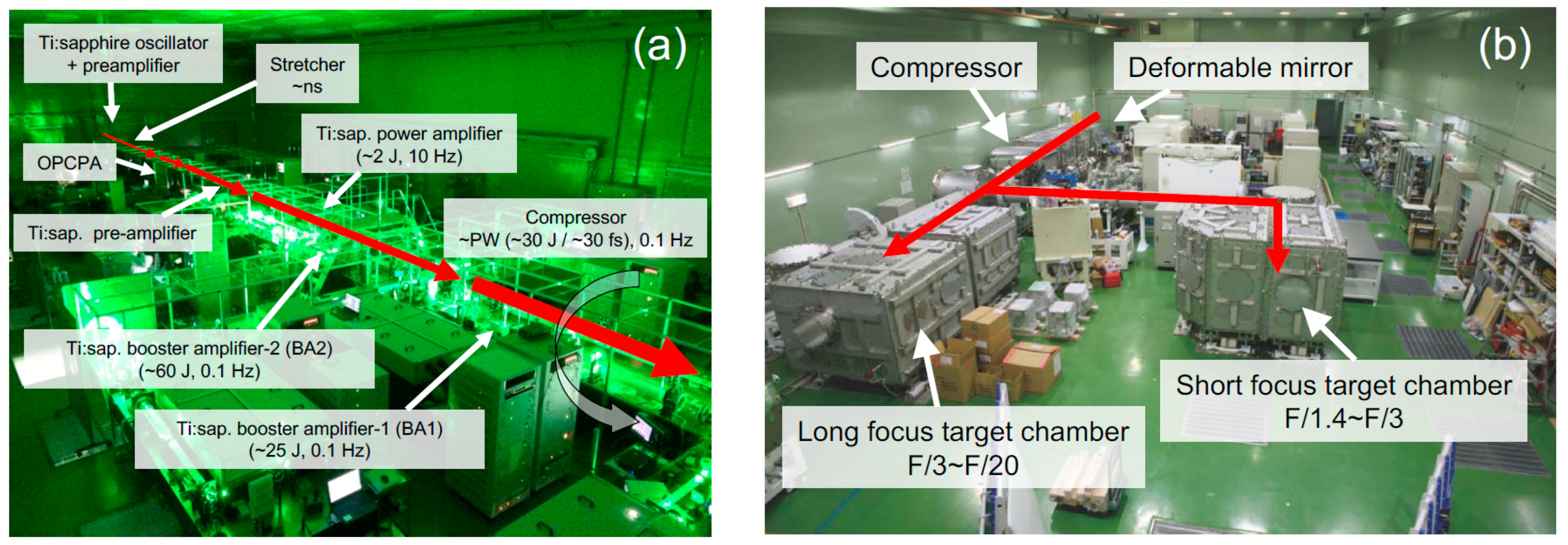
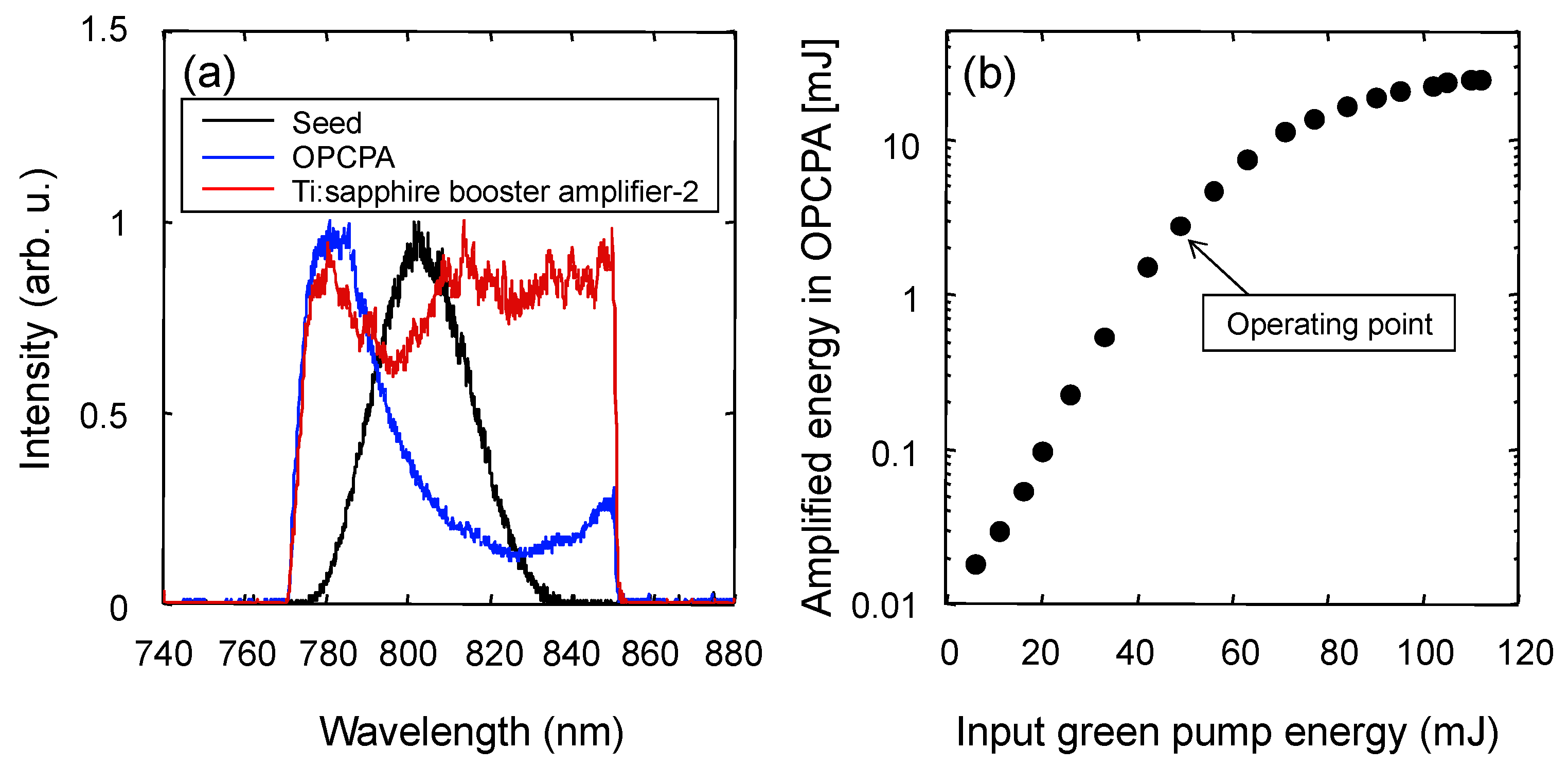

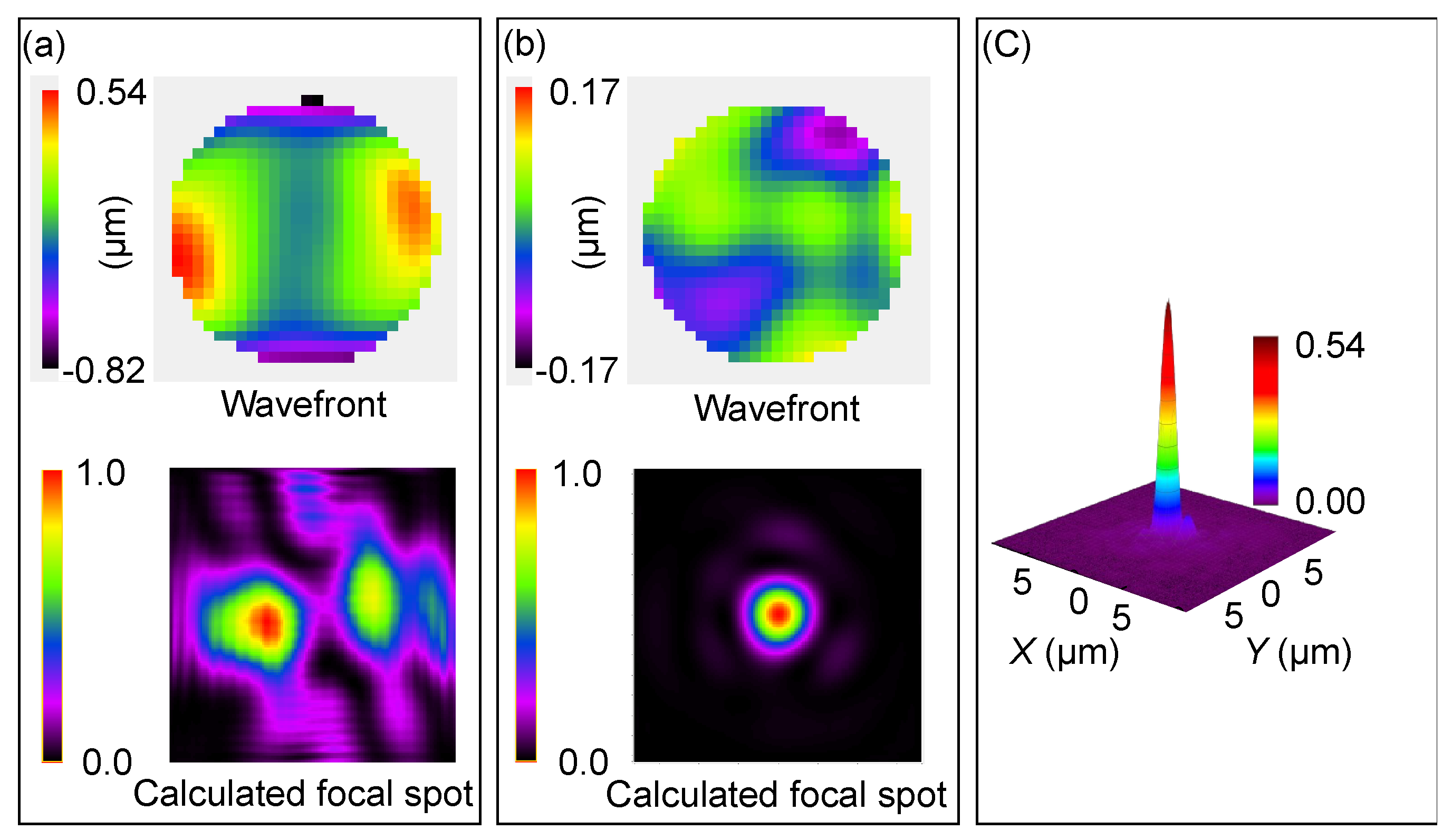
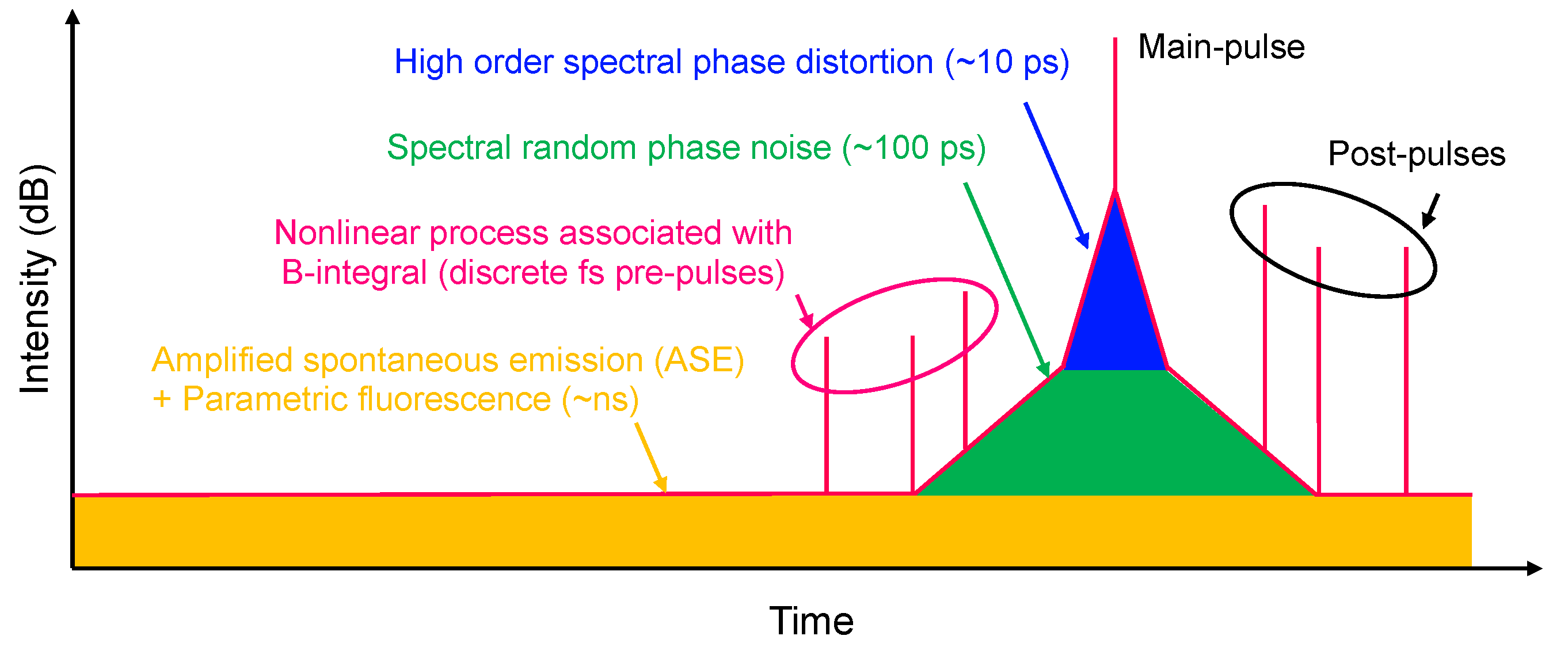


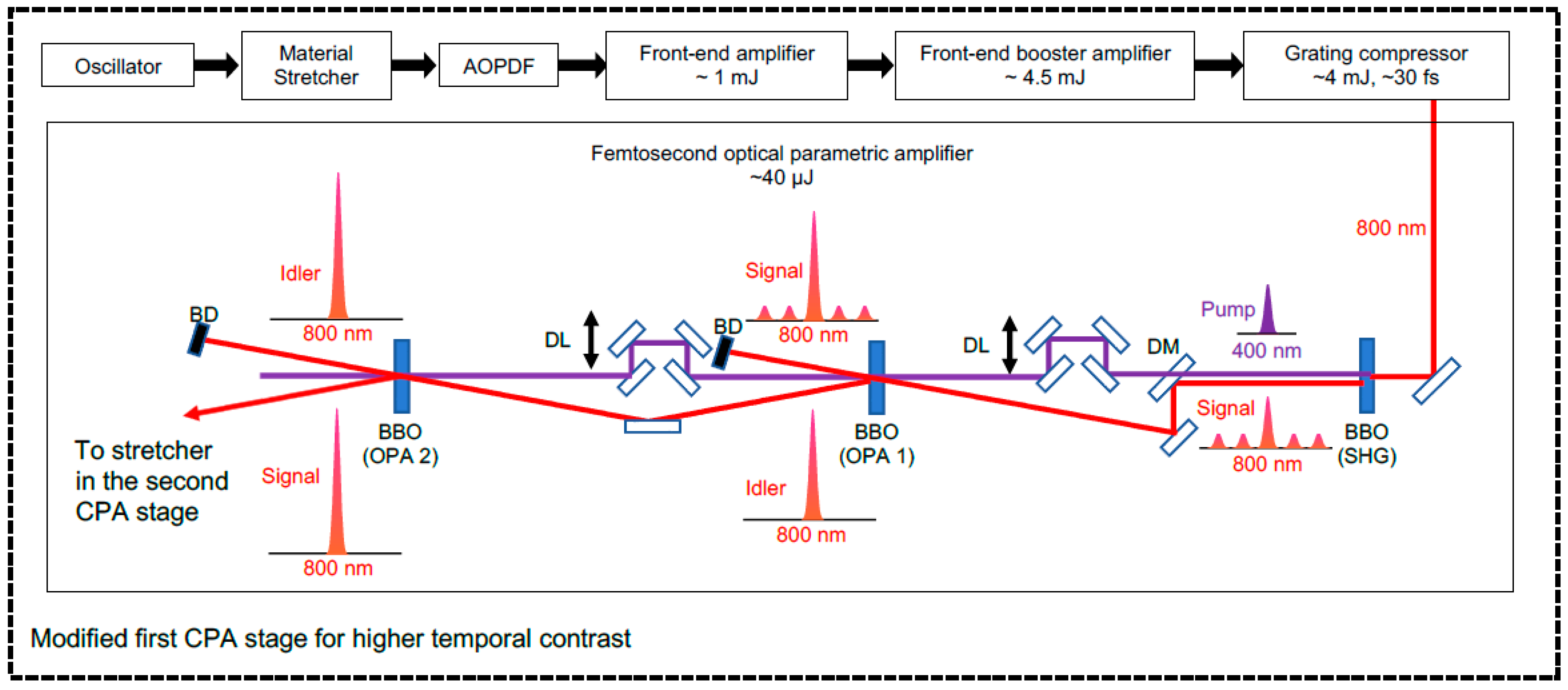
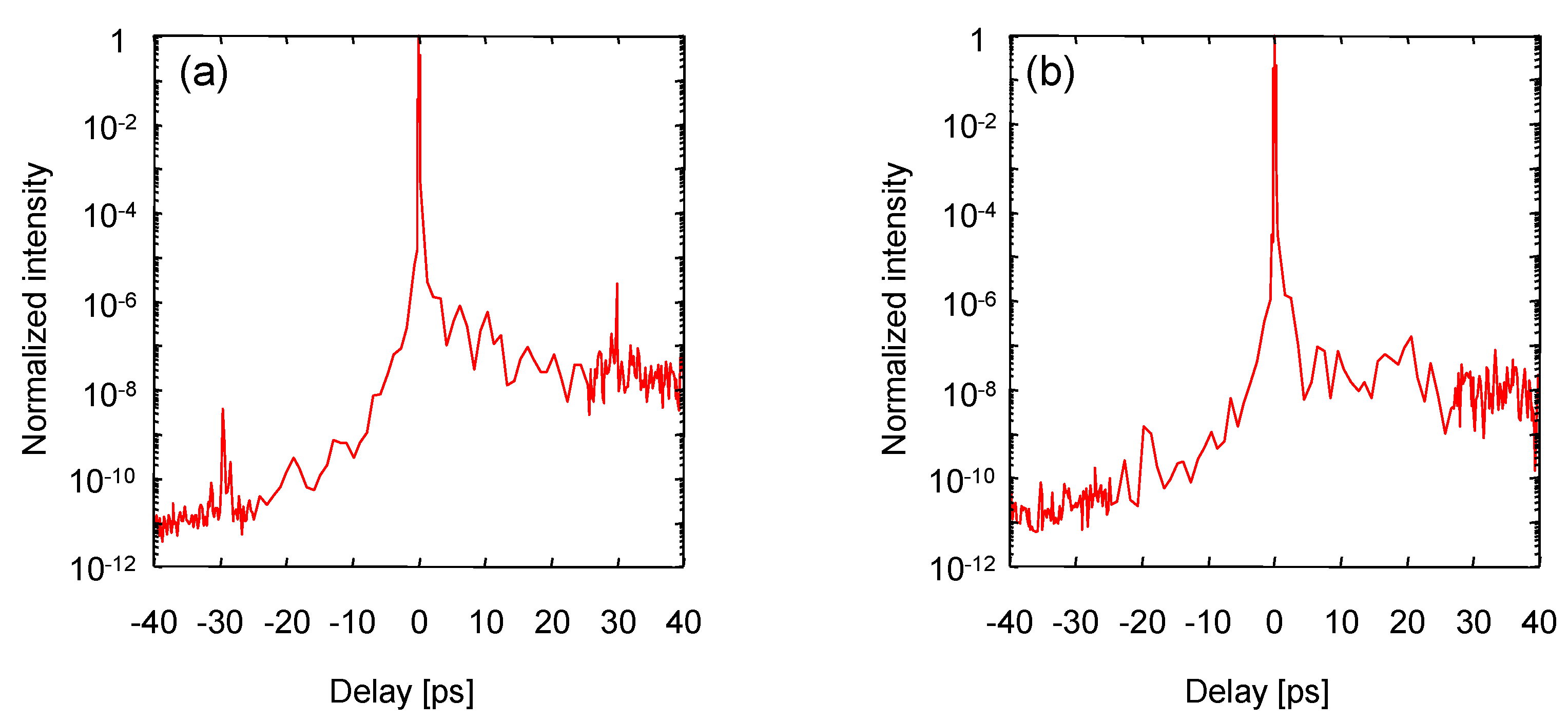
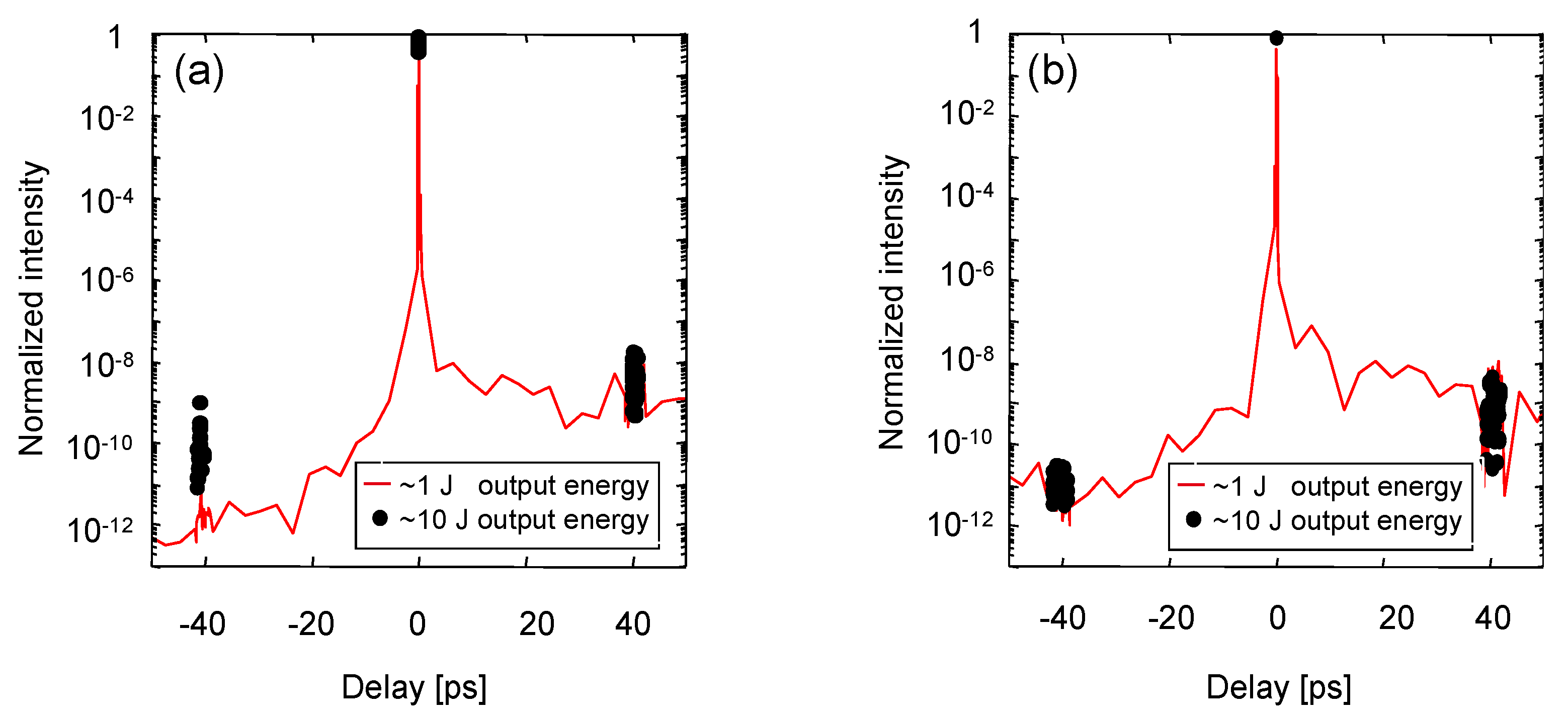
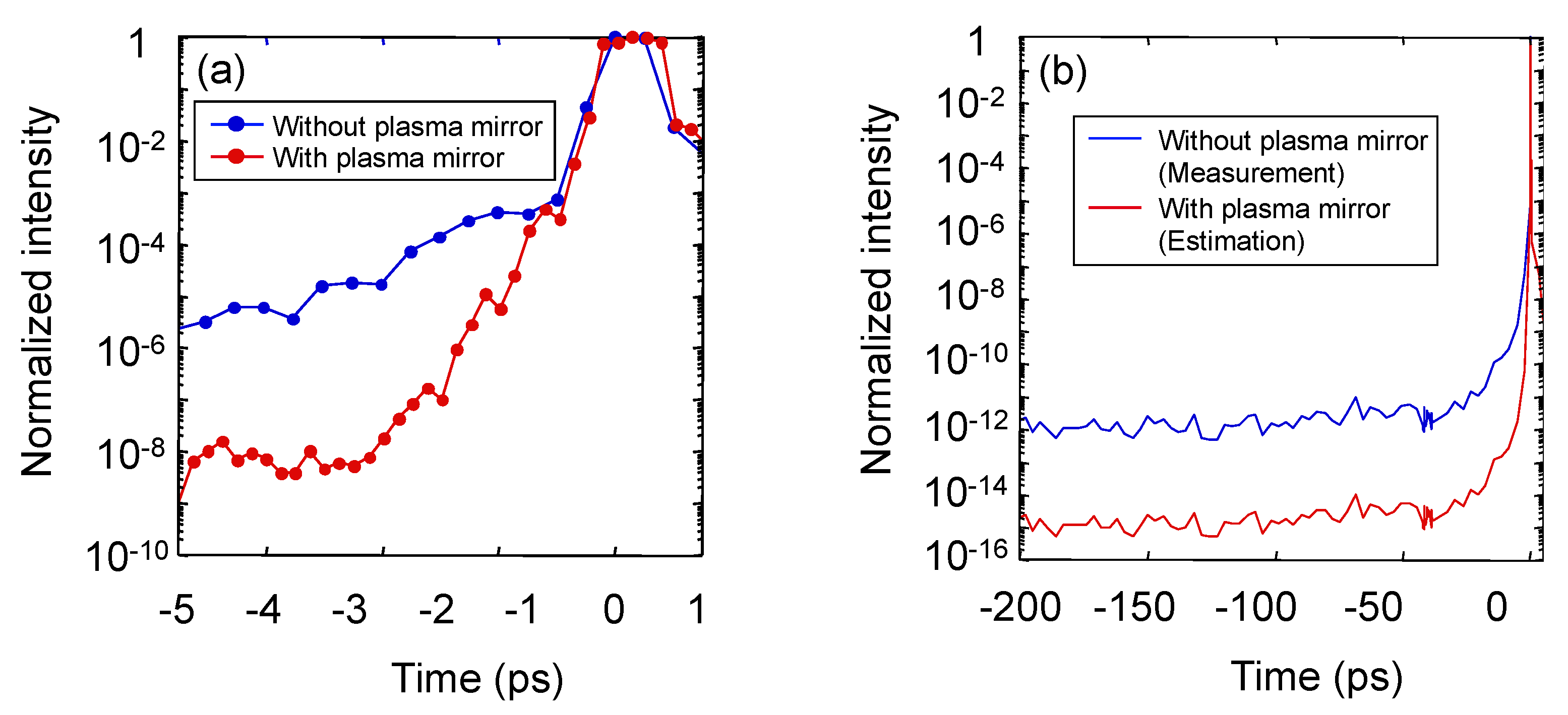

Disclaimer/Publisher’s Note: The statements, opinions and data contained in all publications are solely those of the individual author(s) and contributor(s) and not of MDPI and/or the editor(s). MDPI and/or the editor(s) disclaim responsibility for any injury to people or property resulting from any ideas, methods, instructions or products referred to in the content. |
© 2023 by the authors. Licensee MDPI, Basel, Switzerland. This article is an open access article distributed under the terms and conditions of the Creative Commons Attribution (CC BY) license (https://creativecommons.org/licenses/by/4.0/).
Share and Cite
Kiriyama, H.; Miyasaka, Y.; Kon, A.; Nishiuchi, M.; Sagisaka, A.; Sasao, H.; Pirozhkov, A.S.; Fukuda, Y.; Ogura, K.; Kondo, K.; et al. Laser Output Performance and Temporal Quality Enhancement at the J-KAREN-P Petawatt Laser Facility. Photonics 2023, 10, 997. https://doi.org/10.3390/photonics10090997
Kiriyama H, Miyasaka Y, Kon A, Nishiuchi M, Sagisaka A, Sasao H, Pirozhkov AS, Fukuda Y, Ogura K, Kondo K, et al. Laser Output Performance and Temporal Quality Enhancement at the J-KAREN-P Petawatt Laser Facility. Photonics. 2023; 10(9):997. https://doi.org/10.3390/photonics10090997
Chicago/Turabian StyleKiriyama, Hiromitsu, Yasuhiro Miyasaka, Akira Kon, Mamiko Nishiuchi, Akito Sagisaka, Hajime Sasao, Alexander S. Pirozhkov, Yuji Fukuda, Koichi Ogura, Kotaro Kondo, and et al. 2023. "Laser Output Performance and Temporal Quality Enhancement at the J-KAREN-P Petawatt Laser Facility" Photonics 10, no. 9: 997. https://doi.org/10.3390/photonics10090997





